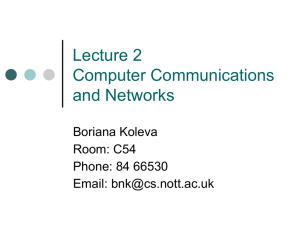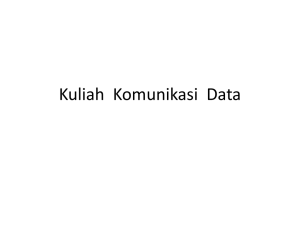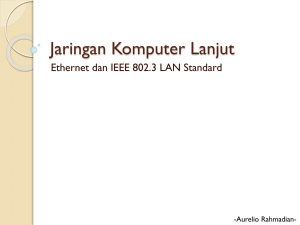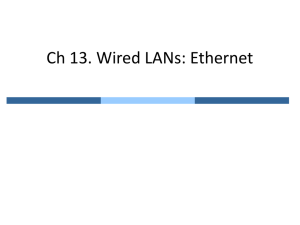Data-link-Ethernet
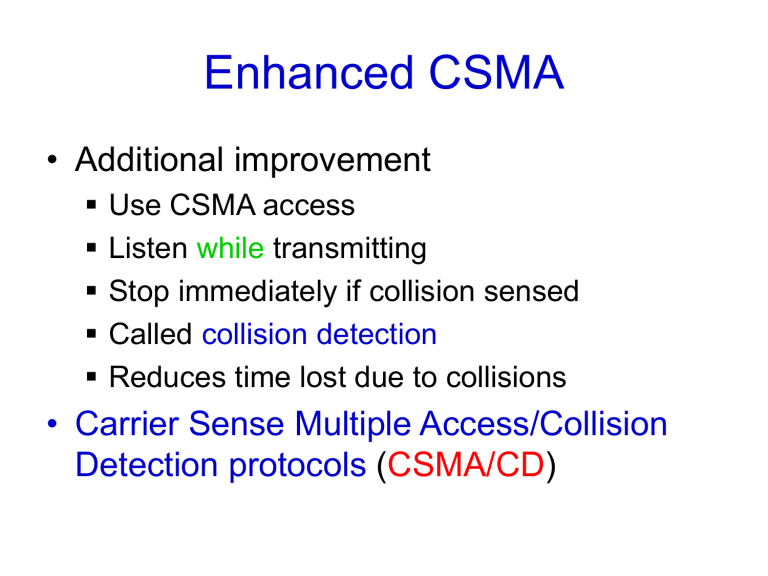
Enhanced CSMA
• Additional improvement
Use CSMA access
Listen while transmitting
Stop immediately if collision sensed
Called collision detection
Reduces time lost due to collisions
• Carrier Sense Multiple Access/Collision
Detection protocols ( CSMA/CD )
CSMA/CD
How long should a station listen while transmitting to ensure no collision?
☼☼ collision
Shared channel
A B
- Suppose A begins to transmit
- Suppose B wants to transmit before hearing A ’s transmission
- How long before A hears collision ?
Collision Detection
• Let p = maximum propagation delay p = time for signal to travel full length of channel
• To ensure detection of a collision , transmitter must listen 2 x propagation delay
• Thus, the time we need listen depends on size of network
• If we set a limit to size of network, we could define a maximum time to listen
• On wired networks we consider propagation delay as 2 * 10
8 meters per second
Collision Detection
• Suppose time to transmit frame is longer than
2 * propagation delay
• What can we say about the channel if we have not heard a collision after 2 * propagation delay?
• By that time, station will have seized the channel
• What if we required a minimum frame size?
• What if the time to transmit a frame of minimum size was ≥ 2 * propagation delay ?
• Under this condition, if transmission completes without collision , we are assured none will occur
Ethernet/IEEE 802.3
• 1975 – Original Ethernet
• Based on a paper by Robert Metcalfe
• Based on Aloha concepts
• 2.94 Mbps (3 Mbps)
• Maximum size of 1 Km
• Used CSMA/CD protocol
• Used coaxial cable as media
• First version developed in collaboration with
• Xerox
• Intel
• Digital Equipment Corporation
Ethernet/IEEE 802.3
• 1980 Ethernet Version 1.0
• 10 Mbps
• 500 meter segment
• Used 50 ohm coaxial cable
• CSMA/CD – 1-persistent
• 1982 Ethernet Version 2.0
• Some electrical revisions
• 1985 IEEE 802.3
• Defined a family of networks
• Minor differences with Ethernet
– Some additional electrical functions
– Frame format variations
IEEE 802.3
• Family of Networks
CSMA/CD 1-persistent
Different speeds
Different media
• 10BASE5 Thick Coax
• 1000BaseT twisted pairs
• Others
500 meters
• 10BASE2
• 10BASET
Thin Coax
Twisted pairs 100 meters
• 10BASEF Fiber
• 100BASET twisted pairs
185 meters
1 & 2 Km
100 meters
100 meters
10BASE5
• 500 meters
• 10 Mbps
• Maximum 100 stations on a segment
• Minimum 2.5 meters apart
• Manchester encoding
± .85 volts
High to low = 1 bit
Low to high = 0 bit
10BASE5
500 meters
Transceiver – Ethernet
Media Access Unit ( MAU ) IEEE
Transceiver/ AUI Cable
50 meters maximum
Attachment Unit Interface ( AUI ) host
How long must we listen to assure no collision?
How large a minimum frame do we need to detect any collision before end of transmission?
10BASE5
500 meters
Repeater
Transceiver/ AUI Cable
50 meters maximum
A
500 meters
How long must we listen to assure no collision?
B
Calculating Propagation Delay
• 100 meters of cable adds .5 µs to delay or
1 µs roundtrip
• Repeater adds approximately .75
µs oneway or 1.5 µs roundtrip
• Transceiver adds 1.0 µs one-way or 2.0 µs roundtrip (if not connected to host)
• On a 10 Mbps Ethernet, 1 µs is equivalent to transmitting 10 bits
• We can calculate delay in time units or in bits
Ethernet/IEEE 802.3
• Use CSMA / CD
• Detect collisions while transmitting frame
• Requires a minimum size frame
Transmission rate (speed)
Frame size
Network size
All related
A
B
500 meters
R
500 meters
R
500 meters
R
500 meters
R
500 meters
10BASE5
5 * 500 segments
= 2500 meters
= 12.5 µs
8 * 50 Transceiver cables
= 400 meters
= 2 µs
4 repeaters * .75 µs
= 3 µs
8 transceivers * 1 µs
= 8 µs
Total one way delay = 25.5 µs
Total round trip = 51 µs
Ethernet/IEEE 802.3
• Minimum frame size = 512 bits
= 64 bytes
• Vulnerable time or contention slot = 51.2 µs
• After 51.2 µs, station has seized channel
• What happens if a station sends unlimited size frame?
• Maximum size frame also specified at 1518 bytes
• Maximum size frame enforced by transceiver
Original Ethernet Diagram
Ethernet Wiring Topologies
Star wired hubs
Shared Channel n Mbps capacity n Mbps
A B C D
All stations share n Mbps
A shared hub is actually a repeater
E F G n Mbps
Efficiency of CSMA/CD
• Let p = propagation delay (one way)
• A = probability a station acquires channel during a contention slot
• Tx = time to transmit an average size frame
• It can be shown that
U
Tx
Tx
2 p
A
Tx
bits / frame speed
• Optimal utilization when A
1 e
Ethernet/IEEE802.3 Utilization
Ethernet/IEEE 802.3
• Advantages
Most widely used network architecture
New stations can be installed on live network
Low delay at low load
Simple access mechanism
• Disadvantages
Limited distances
Non deterministic
High collisions rate at high loads
No provisions for priority traffic
Collisions
• Minimum frame defined as 512 bits
• At 10 Mbps contention slot = 51.2 µs
• After a collision each station waits 0 or 1 contention slots
• After a second collision each station waits 0, 1, 2, or 3 contention slots
• After j collisions, each station waits
0, 1, 2, . . . . . ., 2 j
-1 contention slots until j = 10 then continue until 16 total tries
• This is called binary exponential backoff
Ethernet/IEEE 802.3 Addressing
• Each station on a multiple access LAN must be uniquely identified
• For Ethernet, addresses are assigned to network interfaces by vendors
• Each address is 48 bits
XXXXXX XXXXXX (X = 4 bits) vendors address
• There is a special broadcast address
FFFFFF FFFFFF (all 1s)
All stations on shared channel
• There are provisions for subgroups ( multicast )
• This is called the Media Access Control ( MAC ) address
Ethernet/IEEE 802.3 Addressing
• You can look up the vendor of the adaptor for your machine http://standards.ieee.org/regauth/oui/index.shtml
7
1
6
6
2
Ethernet Frame Format
Ethernet IEEE 802.3
Preamble
SFD
Destination
Address
Source
Address
Type
10101010
………..
101010 11
Preamble
SFD
Destination
Address
Source
Address
Length
7
1
6
6
2
Data
46
–1500 bytes
4
FCS
CRC - 32
LLC Data
46
– 496bytes
FCS
CRC - 32
4

